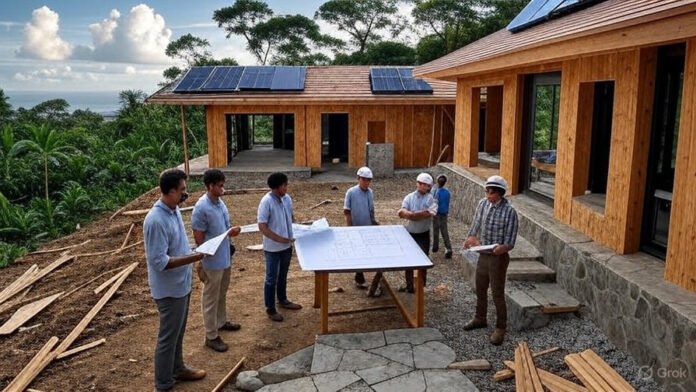Building a home in Costa Rica is a dream for many, drawn by the country’s lush landscapes, vibrant culture, and laid-back lifestyle. However, turning that dream into reality requires careful financial planning and an understanding of the costs involved. From land acquisition to permits, construction, and finishing touches, the process is multifaceted. This article provides a detailed overview of the costs to build a home in Costa Rica in 2025, offering insights into regional variations, sustainability options, and practical tips to ensure a smooth project.
Average Construction Costs in 2025
The cost of building a home in Costa Rica has risen in recent years due to global inflation, increased demand for materials, and labor shortages. According to industry sources, construction costs vary depending on the quality of materials and finishes:
- Basic Construction: $88–$121 per square foot ($947–$1,300 per m²). This tier is suitable for modest homes with standard finishes.
- Mid-Range Construction: $120–$167 per square foot ($1,300–$1,800 per m²). This includes better materials and more refined designs.
- High-End Construction: $167–$190 per square foot ($1,800–$2,050 per m²). These homes feature luxury finishes, custom designs, and premium materials.
These figures are averages and can fluctuate based on location, design complexity, and material choices. For a more detailed breakdown, check out this guide on Cost to Build a Home in Costa Rica.
Regional Cost Variations
Construction costs in Costa Rica vary significantly by region due to differences in accessibility, infrastructure, and demand. Coastal areas like Guanacaste, Tamarindo, and the Nicoya Peninsula tend to have higher costs due to their popularity among expatriates and tourists. In contrast, rural or mountainous regions, such as the Central Valley, often offer more affordable options. Factors influencing these variations include:
- Accessibility: Remote areas may incur higher transportation costs for materials.
- Infrastructure: Properties far from existing utilities may require additional investment in septic systems or water storage.
- Local Demand: High-demand areas like beachfront properties command premium prices for both land and construction.
Prospective homeowners should research their desired region thoroughly to account for these variations in their budget.
Key Steps and Costs in the Building Process
Building a home in Costa Rica involves several stages, each with its own costs and considerations. Below is a breakdown of the key steps:
1. Land Acquisition
The first step is purchasing land, which can vary widely in price. Coastal regions like Guanacaste and Tamarindo are pricier, with costs often exceeding $100 per square meter, while rural areas may offer land for as low as $10–$20 per square meter. Working with a reputable real estate agent and attorney is crucial to ensure a clear title and proper zoning for residential use.
Pro Tip: Verify the land’s zoning and accessibility to utilities before purchasing to avoid costly surprises later.
2. Permits and Legal Fees
Obtaining permits is a critical and regulated process in Costa Rica. Homeowners need several permits, including:
- Land Use Permit: Confirms the property is zoned for residential use.
- Construction Permit: Issued by the local municipality to authorize building.
- Environmental Feasibility Permit: Required for projects near protected areas or with potential environmental impact.
Permit costs typically range from $1,000 to $3,000, while legal fees for navigating the process can add $1,500 to $5,000, depending on project complexity.
3. Architectural and Engineering Fees
Hiring an experienced architect is essential for designing a home suited to Costa Rica’s tropical climate and seismic activity. Architectural fees range from 8% to 15% of the total construction cost, while structural engineering services, which ensure the home withstands earthquakes and heavy rainfall, cost an additional 3% to 6%. Investing in quality design can prevent costly issues like poor ventilation or structural weaknesses.
4. Construction Expenses
The bulk of the budget goes toward construction, which includes labor, materials, and contractor fees. As noted earlier, costs range from $80 to $200 per square foot, depending on the quality of finishes and location. Budgeting for a 10–15% contingency is wise to cover unexpected expenses, such as weather-related delays or material price hikes.
5. Utility and Infrastructure Connections
Connecting to utilities like water, electricity, and sewer systems can cost between $2,000 and $10,000, depending on the property’s proximity to existing infrastructure. In rural areas, homeowners may need to install septic tanks or water storage systems, increasing costs. Internet installation, crucial for remote workers, typically costs $100 to $500.
6. Furniture and Finishes
Once construction is complete, furnishing and decorating the home is the final step. Homeowners can choose between local artisan furniture, which is often sustainable and affordable, or imported high-end finishes. Budgeting 10% to 20% of the total project cost for furnishings is common, with costs varying based on style and preferences.
Pro Tip: Collaborate with local artisans to source unique, eco-friendly furniture that complements Costa Rica’s natural aesthetic.
Embracing Sustainability in Construction
Costa Rica’s commitment to environmental stewardship makes sustainable construction a popular choice. Homeowners can incorporate features like solar panels, energy-efficient appliances, and water conservation systems to reduce their environmental footprint and long-term utility costs. While these options may increase upfront costs by 5–10%, they can lead to significant savings and enhance property value. For more insights, explore this sustainable living guide.
Planning for Success
Building a home in Costa Rica is a rewarding but complex process. To avoid financial pitfalls, work with experienced professionals, including architects, engineers, and project managers, who understand local regulations and conditions. A well-planned budget that accounts for land, permits, construction, utilities, and furnishings is essential. Regular communication with your team can help keep the project on track and within budget.
By understanding the costs and steps involved, you can approach your home-building project with confidence. Whether you’re envisioning a modest retreat or a luxurious coastal villa, Costa Rica offers endless possibilities for creating your dream home.
